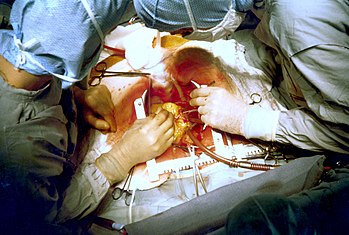Bypass
From WikiLectures
In cardiovascular surgery, the term "bypass" refers to the bridging of a narrowed or closed section of an artery to improve / restore perfusion of the tissue behind the narrowing.
- History
- [1]
- 1953 - Murray performed the first experimental coronary artery bypass (without using extracorporeal circulation).
- 1953 - Gibbon used extracorporeal circulation.
- 1968 - Sones and Favarolo began operating coronary artery bypass grafting in extracorporeal circulation using grafts from the saphenous vein in patients with CHD.
Bypass material: The following can be used to create a bypass:
- venous graft (v. saphena magna, v. saphena parva, superficial veins HK);
- arterial graft (a. thoracica (mammaria) interna, a. radialis from non-dominant HK, a. gastroepiploica dextra, a. epigastrica inferior);
- vascular prosthesis (vascular prostheses are used mainly in places with higher blood flow - aorta, aa. iliacae, aa. femorales; before loading vascular clamps it is necessary to fully heparin isolate the patient , heparinization is canceled after surgery);
- porous prostheses - it is necessary to pre-coagulate the patient's own blood (strongly porous Dacron®, less porous Dacro®, Sauvage doublevelour prosthesis);
- non-porous prostheses - no need to pre-coagulate (Dacron® impregnated with collagen, expanded polytetrafluoroethylene, ePTFE);
- xenograft (bovine a. mammaria).
A vascular prosthesis or xenograft carries a higher risk of complications. They are therefore used only in cases where we do not have our own graft (ie for example in repeated reoperations).
Bypass management method:
- Anatomically - along the original vessel (aortofemoral bypass, femoropopliteal);
- extraanatomically - outside the course of the original vessel (axillofemoral, femorofemoral).
- Vein use in situ vs. reverse graft.
- Use of a vein in situ (we tie larger branches; we remove the valves with a special deletion; we connect the proximal part of the vein to the proximal part of the artery, the distal part of the vein to the distal part of the artery;
- Reverse graft (extirpate the vein, ligate all branches, connect the proximal end of the vein to the distal end of the artery and the distal end of the vein to the proximal end of the artery - so that the venous valves do not impede blood flow).
Links[edit | edit source]
Related Articles[edit | edit source]
- Arterial reconstruction
- Ischemic heart disease
- Chronic ischemic lower limb disease
- Large vein closures
- Vascular prostheses
Reference[edit | edit source]
- ↑ VANĚK, Ivan, et al. Cardiovascular surgery. 1. edition. Prague : Karolinum, 2003. 236 pp. ISBN 8024605236.
Used literature[edit | edit source]
- ZEMAN, Miroslav, et al. Special surgery. 2. edition. Prague : Galen, 2006. 575 pp. ISBN 80-7262-260-9.
- VANĚK, Ivan, et al. Cardiovascular surgery. 1. edition. Prague : Karolinum, 2003. 236 pp. ISBN 8024605236.
Source[edit | edit source]
- BENEŠ, Jiří. Questions from surgery [online]. ©2007. [cit. 14.5.2010]. <jirben2.chytrak.cz/materialy/chira/cevni.doc>.


